sensor PONTIAC GRAND AM 1998 Owners Manual
[x] Cancel search | Manufacturer: PONTIAC, Model Year: 1998, Model line: GRAND AM, Model: PONTIAC GRAND AM 1998Pages: 370, PDF Size: 16.11 MB
Page 33 of 370
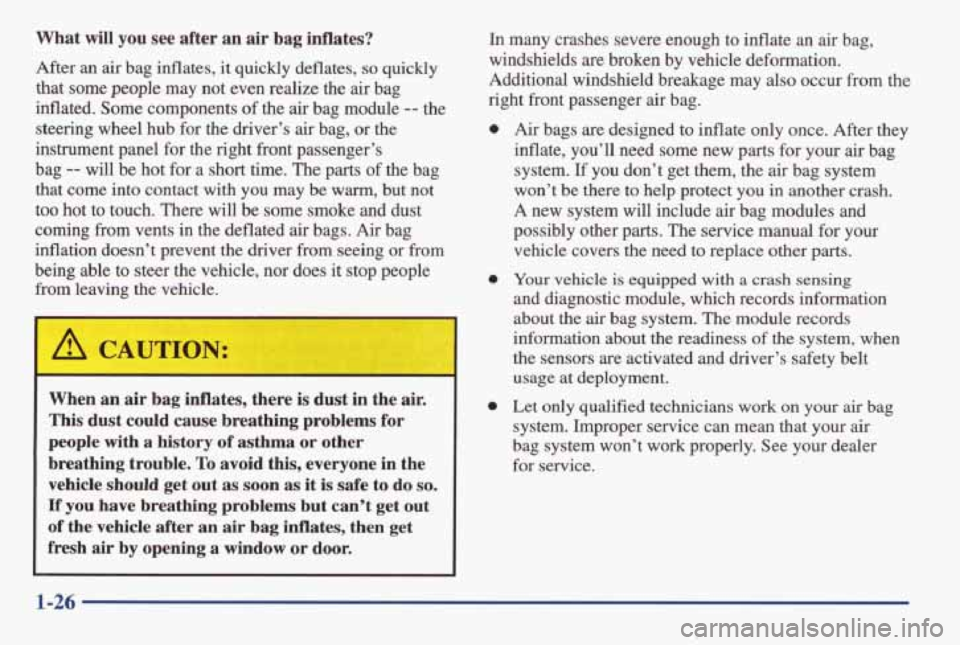
What will you see after an air bag inflates?
After an air bag inflates, it quickly deflates, so quickly
that some people may not even realize the
air bag
inflated. Some components of the
air bag module -- the
steering wheel hub for the driver’s
air bag, or the
instrument panel for the right front passenger’s
bag
-- will be hot for a short time. The parts of the bag
that come into contact with you may be
warm, but not
too hot to touch. There will be some smoke and dust
coming from vents
in the deflated air bags. Air bag
inflation doesn’t prevent the driver from seeing or from
being able to steer the vehicle, nor does it stop people
from leaving
the vehicle.
I
CAUTION:
I
When an air bag inflates, there is dust in the air.
This dust could cause breathing problems for
people with
a history of asthma or other
breathing trouble. To avoid
this, everyone in the
vehicle should get out as soon
as it is safe to do so.
If you have breathing problems but can’t get out
of the vehicle after an air bag inflates, then get
fresh air by opening a window or door.
In many crashes severe enough to inflate an air bag,
windshields are broken by vehicle deformation.
Additional windshield breakage may
also occur from the
right front passenger
air bag.
0
0
Air bags are designed to inflate only once. After they
inflate, you’ll need some new parts for
your air bag
system.
If you don’t get them, the air bag system
won’t be there
to help protect you in another crash.
A new system will include air bag modules and
possibly other parts.
The service manual for your
vehicle covers the need
to replace other parts.
Your vehicle is equipped with a crash sensing
and diagnostic module, which records information
about the
air bag system. The module records
information about the readiness of the system, when
the sensors are activated and driver’s safety belt
usage
at deployment.
Let only qualified technicians work
on your air bag
system. Improper service can mean that your
air
bag system won’t work properly. See your dealer
for service.
1-26
Page 34 of 370
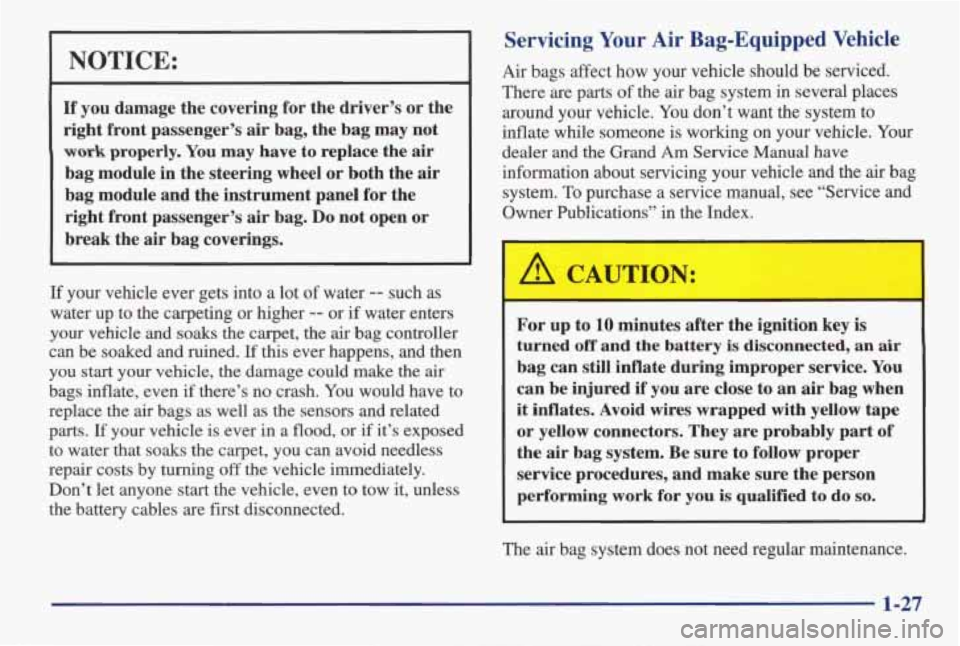
NOTICE:
If you damage the covering for the driver’s or the
right front passenger’s air bag, the bag may not
work properly. You may have to replace the air
bag module in the steering wheel or both the air
bag module and the instrument panel for the
right front passenger’s air bag. Do not open or
break the air bag coverings.
If your vehicle ever gets into a lot of water -- such as
water up to the carpeting or higher
-- or if water enters
your vehicle and
soaks the carpet, the air bag controller
can be soaked and ruined. If this ever happens, and then
you
start your vehicle, the damage could make the air
bags inflate, even if there’s no crash. You would have to
replace the air bags as well as the sensors and related
parts.
If your vehicle is ever in a flood, or if it’s exposed
to water that soaks the carpet, you can avoid needless
repair costs by turning
off the vehicle immediately.
Don’t let anyone start the vehicle, even to tow it, unless
the battery cables are first disconnected.
Servicing Your Air Bag-Equipped Vehicle
Air bags affect how your vehicle should be serviced.
There are parts of the air bag system in several places around your vehicle. You don’t want the system to
inflate while someone
is working on your vehicle. Your
dealer and the Grand Am Service Manual have
information about servicing your vehicle and the air bag system.
To purchase a service manual, see “Service and
Owner Publications” in the Index.
n I
1 A CAUTION:
For up to 10 minutes after the ignition key is
turned off and the battery is disconnected, an air
bag can still inflate during improper service. You
can be injured
if you are close to an air bag when
it inflates. Avoid wires wrapped with yellow tape
or yellow connectors. They are probably part of
the air bag system. Be sure to follow proper
service procedures, and make sure the person
performing
work for you is qualified to do so.
The air bag system does not need regular maintenance.
I
1-27
Page 84 of 370
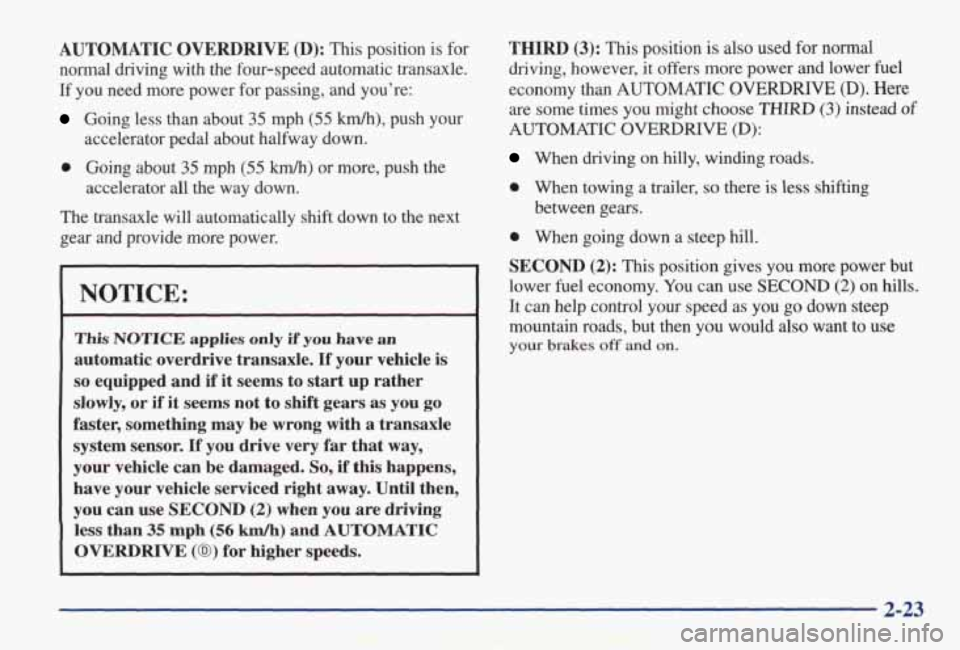
AUTOMATIC OVERDRIVE (D): This position is for
normal driving with the four-speed automatic transaxle.
If you need more power for passing,
and you’re:
Going less than about 35 mph (55 km/h), push your
0 Going about 35 mph (55 km/h) or more, push the
The transaxle will automatically shift down to the next
gear and provide more power. accelerator pedal about halfway down.
accelerator all the way down.
NOTICE:
This NOTICE applies only if you have an
automatic overdrive transaxle. If your vehicle is
so equipped and if it seems to start up rather
slowly,
or if it seems not to shift gears as you go
faster, something may be wrong with a transaxle
system sensor.
If you drive very far that way,
your vehicle can be damaged. So, if this happens,
have your vehicle serviced right away. Until then,
you can use SECOND
(2) when you are driving
less than
35 mph (56 km/h) and AUTOMATIC
OVERDRIVE (0) for higher speeds. THIRD
(3): This
position is also used for normal
driving, however, it offers more power and lower fuel
economy than AUTOMATIC
OVERDRIVE (D). Here
are some times you might choose THIRD (3) instead of
AUTOMATIC
OVERDRIVE (D):
When driving on hilly, winding roads.
0 When towing a trailer, so there is less shifting
between gears.
0 When going down a steep hill.
SECOND
(2): This position gives you more power but
lower fuel economy. You can use
SECOND (2) on hills.
It can help control your speed
as you go down steep
mountain roads, but then you would also want
to use
your brakes off and on.
2-23
Page 104 of 370
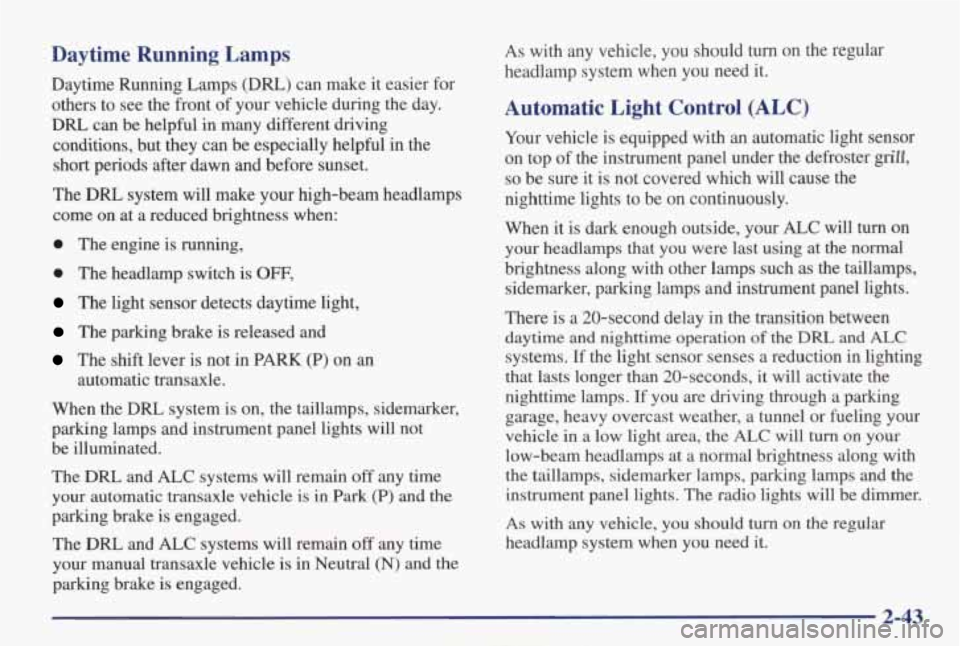
Daytime Running Lamps
Daytime Running Lamps (Dm) can make it easier for
others to see the front of your vehicle during the day.
DRL can be helpful in many different driving
conditions, but they can be especially helpful in the short periods after dawn and before sunset.
The
DRL system will make your high-beam headlamps
come on at a reduced brightness when:
0 The engine is running,
0 The headlamp switch is OFF,
The light sensor detects daytime light,
The parking brake is released and
The shift lever is not in PARK (P) on an
When the DRL system is on, the taillamps, sidemarker,
parking lamps and instrument panel lights will not
be illuminated. automatic transaxle.
The
DIU and ALC systems will remain off any time
your automatic transaxle vehicle is
in Park (P) and the
parking brake is engaged.
The
DFU and ALC systems will remain off any time
your manual transaxle vehicle is in Neutral
(N) and the
parking brake is engaged.
As with any vehicle, you should turn on the regular
headlamp system when you need it.
Automatic Light Control (ALC)
Your vehicle is equipped with an automatic light sensor
on top of the instrument panel under the defroster
grin,
so be sure it is not covered which will cause the
nighttime lights to be on continuously.
When it is dark enough outside,
your ALC will turn on
your headlamps that you were last using at the normal
brightness along with other lamps such as the taillamps,
sidemarker, parking lamps and instrument panel lights.
There is a 20-second delay in the transition between
daytime and nighttime operation
of the DRL and LC
systems. If the light sensor senses a reduction in lighting
that lasts longer than 20-seconds, it will activate the
nighttime lamps. If you are driving through a parking
garage, heavy overcast weather, a tunnel or fueling your
vehicle in a low light area, the
ALC will turn on your
low-beam headlamps at a normal brightness along with
the taillamps, sidemarker lamps, parking lamps and the
instrument panel lights. The radio lights will be dimmer.
As with any vehicle, you should turn on the regular
headlamp system when you need
it.
Page 118 of 370
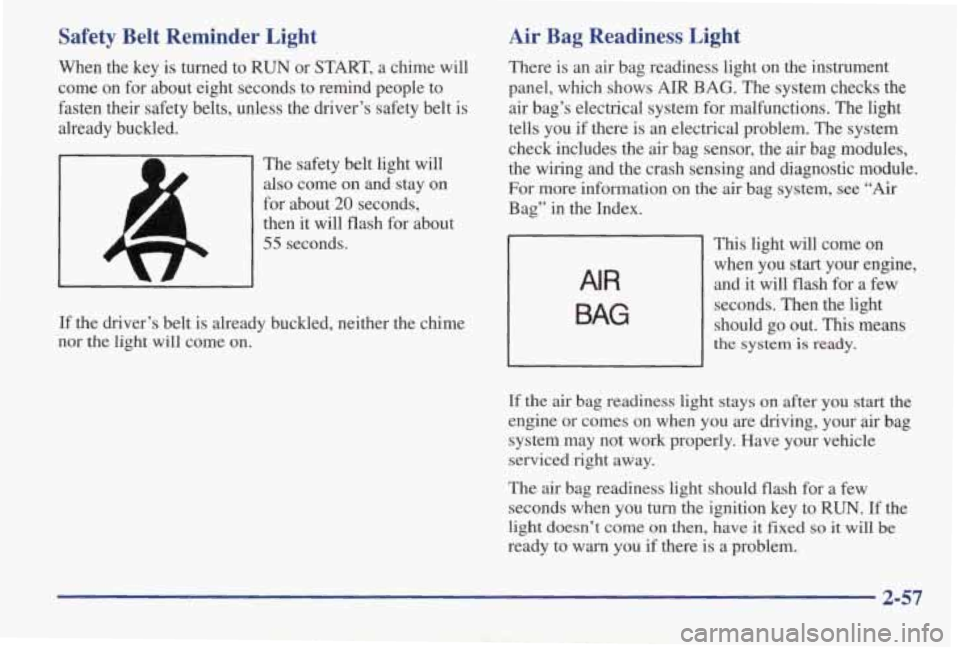
Safety Belt Reminder Light
When the key is turned to RUN or START, a chime will
come on for about eight seconds to remind people to
fasten their safety belts, unless the driver’s safety belt is
already buckled.
The safety belt light will
also come
on and stay on
for about 20 seconds,
then it will flash for about
55 seconds.
If the driver’s belt is already buckled, neither the chime
nor
the light will come on.
AIR
Air Bag Readiness Light
There is an air bag readiness light on the instrument
panel, which shows AIR
BAG. The system checks the
air bag’s electrical system for malfunctions. The light
tells you if there is an electrical problem. The system
check includes the air bag sensor, the air bag modules,
the wiring and the crash sensing and diagnostic module.
For more information on the
air bag system, see “Air
Bag” in the Index.
This light will come on
when you start your engine,
and it will flash for a few
seconds. Then the light
should go out. This means
the system is ready.
If the air bag readiness light stays on after you start the
engine or comes on when you are driving, your
air bag
system may not work properly. Have your vehicle
serviced right away.
The
air bag readiness light should flash for a few
seconds when you turn the ignition key to RUN.
If the
light doesn’t come on then, have it fixed so it will be
ready to warn you if there is a problem.
BAG
2-57
Page 295 of 370
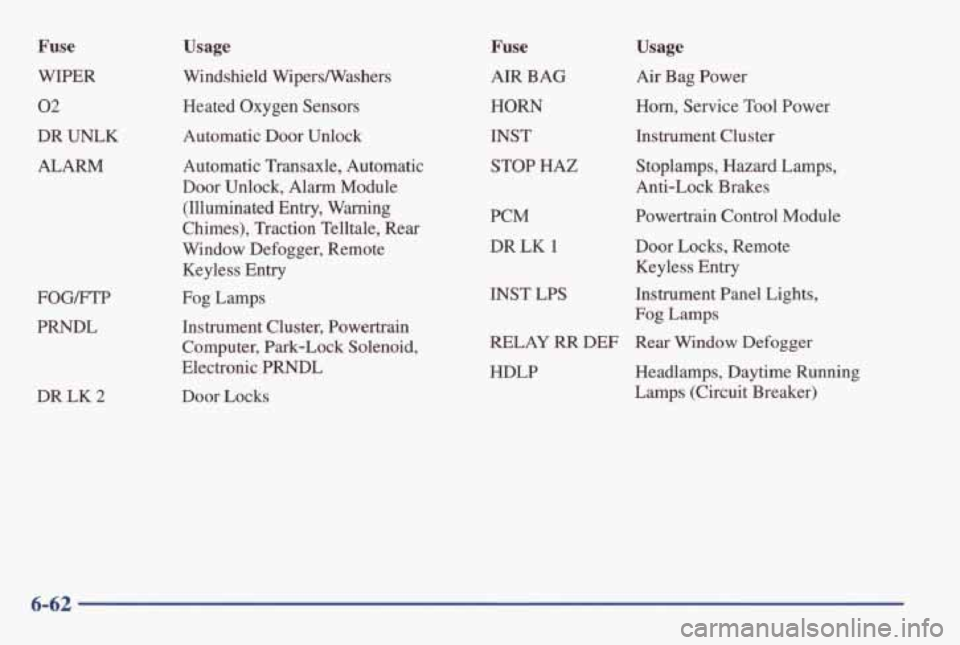
Fuse
WIPER
02
DR UNLK
ALARM
FOG/FTP
PRNDL
DR LK
2
Usage
Windshield Wipersmashers
Heated Oxygen Sensors
Automatic Door Unlock
Automatic Transaxle, Automatic
Door Unlock, Alarm Module (Illuminated Entry, Warning
Chimes), Traction Telltale, Rear
Window Defogger, Remote
Keyless Entry
Fog Lamps
Instrument Cluster, Powertrain
Computer,
Park-Lock Solenoid,
Electronic PRNDL
Door Locks
Fuse
AIR BAG
HORN
INST
STOP HAZ
PCM
DR LK
1
Usage
Air Bag Power
Horn, Service Tool Power
Instrument Cluster
Stoplamps, Hazard Lamps,
Anti-Lock Brakes
Powertrain Control Module
Door Locks, Remote
Keyless Entry
Fog Lamps
INST LPS Instrument Panel Lights,
RELAY RR DEF Rear Window Defogger
HDLP Headlamps, Daytime Running Lamps (Circuit Breaker)
6-62